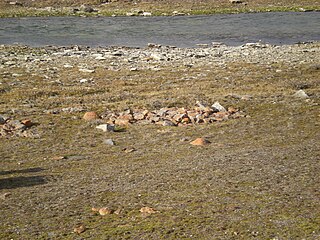
The quarter, short for quarter dollar, is a United States coin worth 25 cents, one-fourth of a dollar. It has a diameter of .955 inches (24.26 mm) and a thickness of .069 inches (1.75 mm). The coin sports the profile of George Washington on its obverse, and its reverse design has changed frequently. It has been produced on and off since 1796 and consistently since 1831.
Coins of the United States dollar were first minted in 1792. New coins have been produced annually since then and they make up a valuable aspect of the United States currency system. Today, circulating coins exist in denominations of 1¢, 5¢, 10¢, 25¢, 50¢, and $1.00. Also minted are bullion and commemorative coins. All of these are produced by the United States Mint. The coins are then sold to Federal Reserve Banks which in turn are responsible for putting coins into circulation and withdrawing them as demanded by the country's economy.

The Coinage Act of 1873 or Mint Act of 1873, 17 Stat. 424, was a general revision of the laws relating to the Mint of the United States. In abolishing the right of holders of silver bullion to have their metal struck into fully legal tender dollar coins, it ended bimetallism in the United States, placing the nation firmly on the gold standard. Because of this, the act became contentious in later years, and was denounced by some as the "Crime of '73".

A nickel, in American usage, is a five-cent coin struck by the United States Mint. Composed of 75% copper and 25% nickel, the piece has been issued since 1866. Its diameter is .835 inches and its thickness is .077 inches (1.95 mm). Due to inflation, the purchasing power of the nickel continues to drop and currently the coin represents less than 1% of the federal hourly minimum wage. In 2015, over 1.5 billion nickels were produced at the Philadelphia and Denver mints.
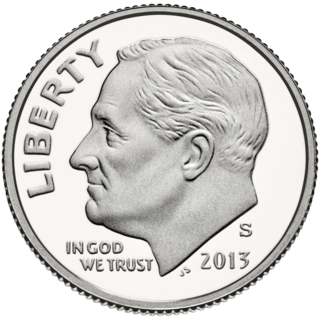
The dime, in U.S. usage, is a ten-cent coin, one tenth of a United States dollar, labeled formally as "one dime". The denomination was first authorized by the Coinage Act of 1792. The dime is the smallest in diameter and is the thinnest of all U.S. coins currently minted for circulation, being .705 inch (17.91 mm) in diameter and .053 inch (1.35 mm) in thickness. The obverse of the coin depicts the profile of President Franklin D. Roosevelt and the reverse boasts an olive branch, a torch, and an oak branch, from left to right respectively. As of 2011, the dime coin cost 5.65 cents to produce.

The two-cent piece was produced by the Mint of the United States for circulation from 1864 to 1872 and for collectors in 1873. Designed by James B. Longacre, there were decreasing mintages each year, as other minor coins such as the nickel proved more popular. It was abolished by the Mint Act of 1873.
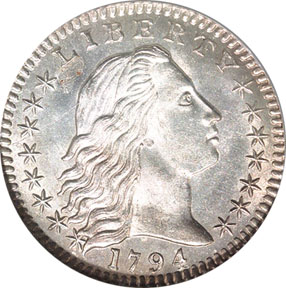
The half dime, or half disme, was a silver coin, valued at five cents, formerly minted in the United States.

The American twenty-cent piece is a coin struck from 1875 to 1878, but only for collectors in the final two years. Proposed by Nevada Senator John P. Jones, it proved a failure due to confusion with the quarter, to which it was close in both size and value.
The Hong Kong coinage, including 10¢, 20¢, 50¢, $1, $2, $5 & $10, is issued by Hong Kong Monetary Authority on behalf of the Government of Hong Kong. From 1863 until 1992 these coins were embossed with the reigning British monarch's effigy. From January 1993 to November 1994, a new series depicting the bauhinia flower was gradually issued, including a new denomination of $10. Since the beginning of the coin replacement programme in 1993, over 585 million coins featuring Queen Elizabeth II have been withdrawn from circulation. However, these coins remain legal tender. The total value of coins in circulation in Hong Kong can be found in Monthly Statistical Bulletin and the Annual Report

The Indian Head cent, also known as an Indian Head penny, was a one-cent coin ($0.01) produced by the United States Bureau of the Mint from 1859 to 1909. It was designed by James Barton Longacre, the Chief Engraver at the Philadelphia Mint.
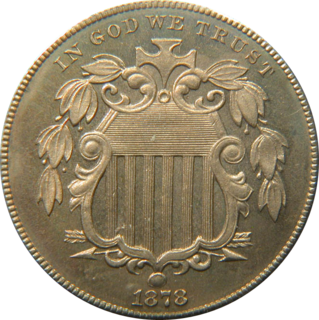
The Shield nickel was the first United States five-cent piece to be made out of copper-nickel, the same alloy of which American nickels are struck today. Designed by James B. Longacre, the coin was issued from 1866 until 1883, when it was replaced by the Liberty Head nickel. The coin takes its name from the motif on its obverse, and was the first five-cent coin referred to as a "nickel"—silver pieces of that denomination had been known as half dimes.

The Barber coinage consists of a dime, quarter, and half dollar designed by United States Bureau of the Mint Chief Engraver Charles E. Barber. They were minted between 1892 and 1916, though no half dollars were struck in the final year of the series.
Canadian coinage is the coinage of Canada, produced by the Royal Canadian Mint and denominated in Canadian dollars ($) and the subunit of dollars, cents (¢). An effigy of the reigning monarch always appears on the obverse of all coins. There are standard images which appear on the reverse, but there are also commemorative and numismatic issues with different images on the reverse.

The American Buffalo, also known as a gold buffalo, is a 24-karat bullion coin first offered for sale by the United States Mint on June 22, 2006, and available for shipment beginning on July 13. The coin follows the design of the Indian Head nickel and has gained its nickname from the American Bison on the reverse side of the design. This was the first time ever that the United States Government has minted pure (.9999) 24-karat gold coins for the public. The coin has a legal tender (face) value of US$50. Due to a combination of the coin's popularity and the tremendous increase in the price of gold since its creation the coin's value has increased considerably in a short time of just a few years. The initial 2006 U.S. Mint price of the proof coin was $800. In 2007 the Mint proof coin was $899.95, $1,410.00 in 2009, and $2,010.00 in 2011.

The three-dollar piece was a gold coin produced by the United States Bureau of the Mint from 1854 to 1889. Authorized by the Act of February 21, 1853, the coin was designed by Mint Chief Engraver James B. Longacre. The obverse bears a representation of Lady Liberty wearing a headdress of a Native American princess and the reverse a wreath of corn, wheat, cotton, and tobacco.

"Draped Bust" was the name given to a design of United States coins. It appeared on much of the regular-issue copper and silver United States coinage, 1796–1807. It was designed by engraver Robert Scot.
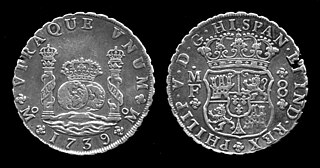
The numismatic history of the United States began with Colonial coins and paper money; most notably the foreign but widely accepted Spanish piece of eight, ultimately descended from the Joachimsthaler and the direct ancestor of the U.S. Dollar.
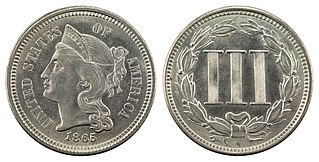
The copper-nickel three-cent piece, often called a three-cent nickel piece or three-cent nickel, was designed by US Mint Chief Engraver James B. Longacre and struck by the United States Bureau of the Mint from 1865 to 1889. It was initially popular, but its place in commerce was supplanted by the five-cent piece, or nickel.
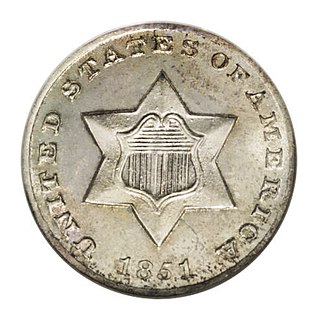
The three-cent silver, also known as the three-cent piece in silver or trime, was struck by the Mint of the United States for circulation from 1851 to 1872, and as a proof coin in 1873. Designed by the Mint's chief engraver, James B. Longacre, it circulated well while other silver coinage was being hoarded and melted, but once that problem was addressed, became less used. It was abolished by Congress with the Coinage Act of 1873.









